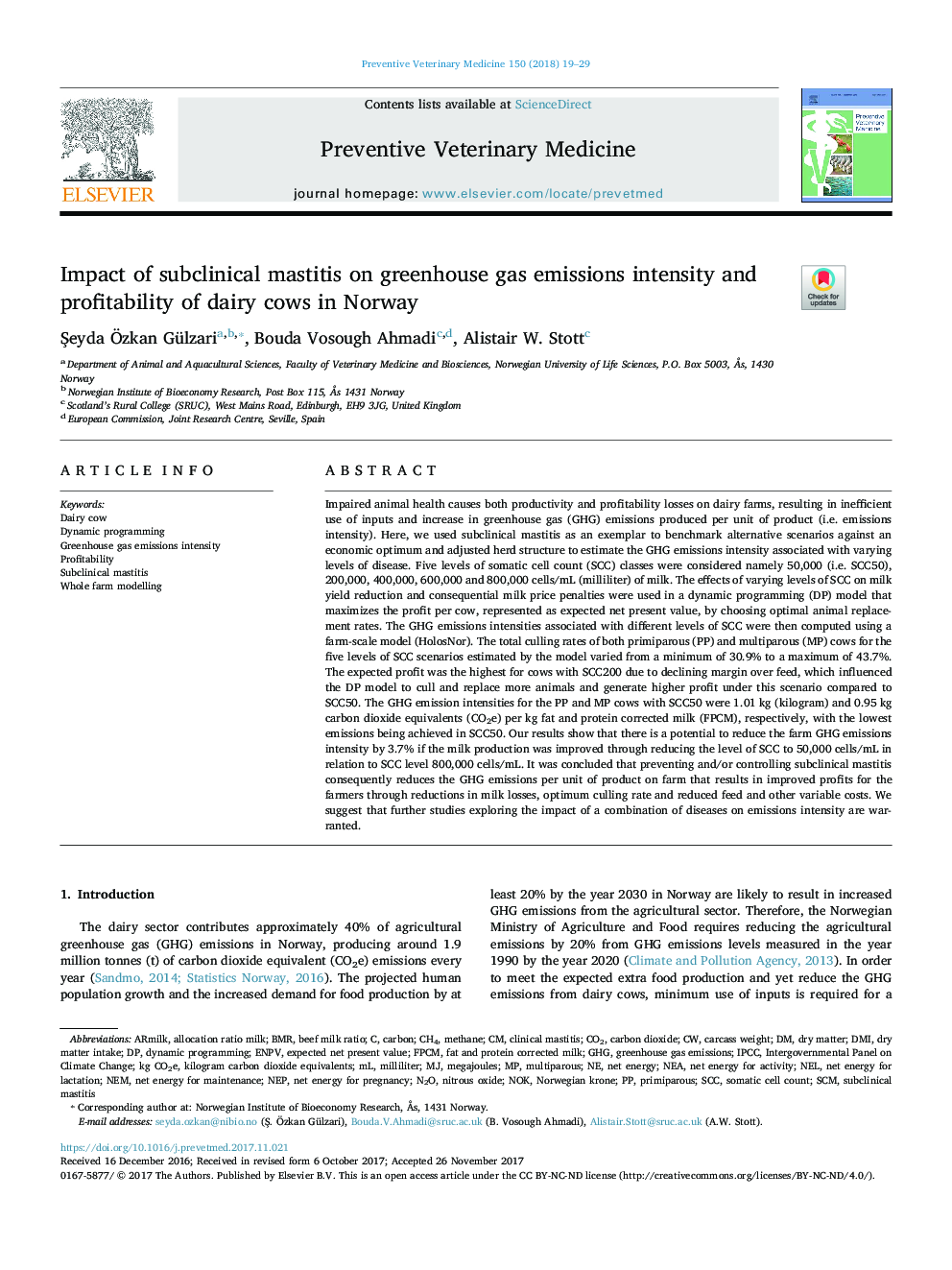| کد مقاله | کد نشریه | سال انتشار | مقاله انگلیسی | نسخه تمام متن |
|---|---|---|---|---|
| 8503552 | 1554140 | 2018 | 11 صفحه PDF | دانلود رایگان |
عنوان انگلیسی مقاله ISI
Impact of subclinical mastitis on greenhouse gas emissions intensity and profitability of dairy cows in Norway
ترجمه فارسی عنوان
تأثیر ماسفتی زیر کلاینت بر شدت انتشار گلخانه ای و سودآوری گاوهای شیری در نروژ
دانلود مقاله + سفارش ترجمه
دانلود مقاله ISI انگلیسی
رایگان برای ایرانیان
کلمات کلیدی
DMIeNPVWhole farm modellingBMRSCMIPCCGHGN2OCH4SCCNEAPrimiparous - ابتداییExpected net present value - ارزش فعلی خالص مورد انتظارGreenhouse gas emissions - انتشار گازهای گلخانه ایnet energy - انرژی خالصnet energy for lactation - انرژی خالص برای شیردهیnet energy for maintenance - انرژی خالص برای نگهداریNitrous oxide - اکسید نیتروژنDynamic programming - برنامهریزی پویا یا برنامه نویسی پویاSomatic cell count - تعداد سلول های سوماتیکNEL - درCarbon dioxide - دیاکسید کربنProfitability - سودآوریdry matter - ماده خشکClinical mastitis - ماستیت بالینیSubclinical mastitis - ماستیت زیر بالینیMethane - متان FPCM - مجوعه کنترل پمپ بنزینdry matter intake - مصرف ماده خشکmilliliter - میلی لیترNEM - نهNEP - نپIntergovernmental Panel on Climate Change - هیات بین دولتی در مورد تغییرات اقلیمیCarcass weight - وزن لاشهFat and protein corrected milk - چربی و پروتئین اصلاح شیرMultiparous - چند ضلعیNok - کافیCarbon - کربنCO2 - کربن دیاکسیدDairy cow - گاو شیری
موضوعات مرتبط
علوم زیستی و بیوفناوری
علوم کشاورزی و بیولوژیک
علوم دامی و جانورشناسی
چکیده انگلیسی
Impaired animal health causes both productivity and profitability losses on dairy farms, resulting in inefficient use of inputs and increase in greenhouse gas (GHG) emissions produced per unit of product (i.e. emissions intensity). Here, we used subclinical mastitis as an exemplar to benchmark alternative scenarios against an economic optimum and adjusted herd structure to estimate the GHG emissions intensity associated with varying levels of disease. Five levels of somatic cell count (SCC) classes were considered namely 50,000 (i.e. SCC50), 200,000, 400,000, 600,000 and 800,000Â cells/mL (milliliter) of milk. The effects of varying levels of SCC on milk yield reduction and consequential milk price penalties were used in a dynamic programming (DP) model that maximizes the profit per cow, represented as expected net present value, by choosing optimal animal replacement rates. The GHG emissions intensities associated with different levels of SCC were then computed using a farm-scale model (HolosNor). The total culling rates of both primiparous (PP) and multiparous (MP) cows for the five levels of SCC scenarios estimated by the model varied from a minimum of 30.9% to a maximum of 43.7%. The expected profit was the highest for cows with SCC200 due to declining margin over feed, which influenced the DP model to cull and replace more animals and generate higher profit under this scenario compared to SCC50. The GHG emission intensities for the PP and MP cows with SCC50 were 1.01Â kg (kilogram) and 0.95Â kg carbon dioxide equivalents (CO2e) per kg fat and protein corrected milk (FPCM), respectively, with the lowest emissions being achieved in SCC50. Our results show that there is a potential to reduce the farm GHG emissions intensity by 3.7% if the milk production was improved through reducing the level of SCC to 50,000Â cells/mL in relation to SCC level 800,000Â cells/mL. It was concluded that preventing and/or controlling subclinical mastitis consequently reduces the GHG emissions per unit of product on farm that results in improved profits for the farmers through reductions in milk losses, optimum culling rate and reduced feed and other variable costs. We suggest that further studies exploring the impact of a combination of diseases on emissions intensity are warranted.
ناشر
Database: Elsevier - ScienceDirect (ساینس دایرکت)
Journal: Preventive Veterinary Medicine - Volume 150, 1 February 2018, Pages 19-29
Journal: Preventive Veterinary Medicine - Volume 150, 1 February 2018, Pages 19-29
نویسندگان
Åeyda Ãzkan Gülzari, Bouda Vosough Ahmadi, Alistair W. Stott,
